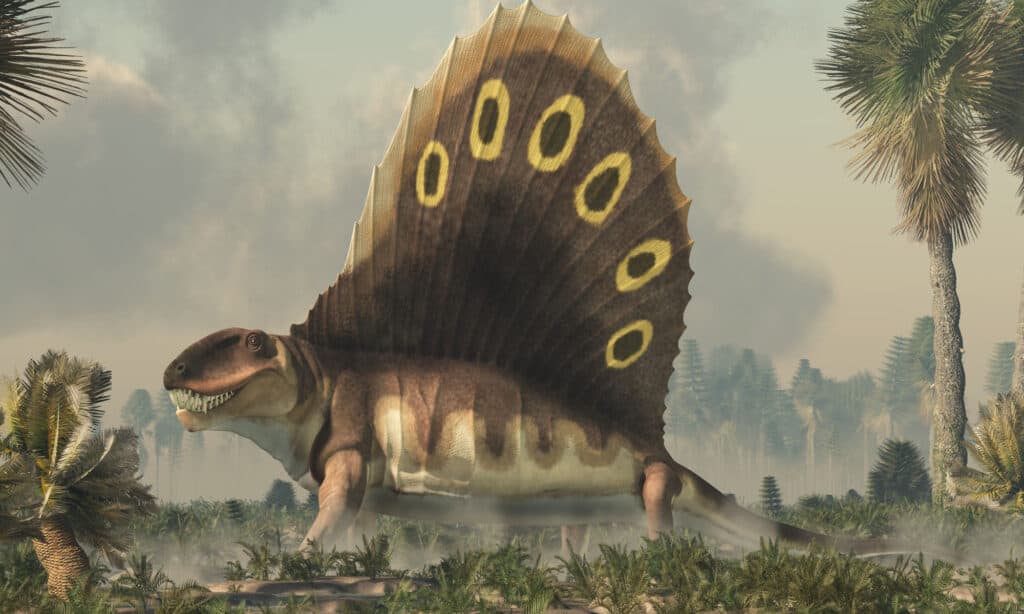Like a lot of kids, you probably had some toy dinosaurs when you were growing up. Do you remember the one that looked like a big iguana with a tall fin on its back? What was that dinosaur anyway? Did it live at the same time as the stegosaurus? And what purpose did its fin serve? In this article, we’re going to discover the dimetrodon and reveal some surprises, such as the fact that this dinosaur with a fin on its back isn’t even a dinosaur!

The Dimetrodon had elongated spines extending from its vertebrate.
©Dziurek/Shutterstock.com
The Dinosaur That Isn’t a Dinosaur
Let’s get this out of the way right off the bat: dimetrodon was not a dinosaur. What was it then? An extinct prehistoric reptile. Isn’t that the same thing as a dinosaur? Not exactly . . .
The term “dinosaur” is used for a specific kind of prehistoric reptile that had some common features. One of the most important of these is that dinosaurs had a hole in their hip socket that allowed them to walk upright, with their legs directly under them. That helped them to stride smoothly in a straight line and run quickly. This is different from the way other reptiles, like crocodiles or iguanas, move in a side-to-side way when they walk. What this means is that not only was the dimetrodon not a dinosaur, flying reptiles like the pteranodon and swimming ones like the plesiosaur were also not dinosaurs, at least according to the specialists. But technically, modern birds are. So, if dimetrodon is not a dinosaur, why do we call it one in this article title? Because for non-specialists like us . . . well . . . we still call it a dinosaur (wink). Because honestly, we care more about the giant prehistoric reptile part than the legs located under the body part. Just keep this in mind if you ever become a paleontologist or just want to drop some knowledge at a party.

Pteranodon flew over water looking for fish and other prey.
©iStock.com/Space-kraft
Dimetrodon’s Look
Dimetrodon was not exactly a gigantic animal, but it was big enough to notice, that’s for sure. It measured anywhere from 5.6–15.1 feet long and weighed 62–551 pounds. For comparison, a Komodo dragon today can get up to 10.3 feet long and weigh as much as 180 pounds. It had four legs, jaws full of teeth of different sizes, and a tail. The most noticeable thing about it, of course, was its spine sail that was made of its spine bones that grew up to five feet long. What was that sail for? Scientists don’t know for sure but have some good theories. For many years the leading theory was that it was for thermal regulation. Skin stretched between the sail bones could absorb more heat when this cold-blooded reptile was sunning itself and disperse more heat when it needed to cool down. More recently, opinion is shifting toward the idea that it was not effective at regulating temperature and instead was probably used in courtship displays to attract mates and intimidate rivals.
Did dimetrodon ever meet up with stegosaurus? No, it didn’t. Stegosaurus didn’t come on the scene until the Jurassic period, about 150 million years ago. And the features on the back of stegosaurus are quite different – bony plates, instead of long finger-like bones with skin between them. These may have served similar purposes to dimetrodon’s sail, but more likely were also important for the defense of stegosaurus because it was a herbivore threatened by a lot of powerful Jurassic-era carnivores.

Researchers think this dinosaur probably used its fin for courtship displays.
©Daniel Eskridge/Shutterstock.com
Dimetrodon’s Land and Lunch
Where did this dinosaur with a fin on its back live? Most of the fossils we have discovered of this species are from Texas, Oklahoma, and other places in the American Southwest. Recently, some fossils have been discovered in Germany. Dimetrodon lived during the Cisuralian (Early Permian) period, which was about 295-275 million years ago. With all those teeth, dimetrodon was certainly a carnivore. Paleontologists think dimetrodon was the apex predator in a swampy delta region similar to the modern Everglades. It may have fed on amphibians and reptiles, and fish and sharks that got into shallow waters. There has been debate about how much Dimetrodon could function in the water, but most researchers think it was likely a land creature that would have strayed into the shallows when a possible meal presented itself.

As an inhabitant of a swampy river delta, dimetrodon may have been able to hunt in shallow water as well as on land.
©U.S. Fish and Wildlife Service Headquarters, Public domain, via Wikimedia Commons – License
What Happened to Dimetrodon?
The last dimetrodon went extinct at the end of the Permian period. This was an extinction event called “The Great Dying” which is different from the much later asteroid impact that killed the dinosaurs. At the time dimetrodon died out, enormous volcanic eruptions happened in what is today Siberia, releasing a vast amount of carbon dioxide. This raised global temperatures and acidified the pH balance of the oceans, resulting in about 97% of all life on Earth going extinct, both on land and in the ocean. It’s certainly a sobering warning to us today about both the fragility and resilience of life on our planet.
The photo featured at the top of this post is © Wirestock Creators/Shutterstock.com
Thank you for reading! Have some feedback for us? Contact the AZ Animals editorial team.






